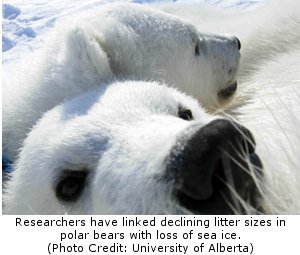
Edmonton, Alberta, Canada
– “Projected reductions in the number of newborn cubs are a significant
threat to the western Hudson Bay polar-bear population,” said lead
researcher Péter K. Molnár, from the Department of Biological Sciences, University of Alberta. “If climate change continues unabated, the viability of the species across much of the Arctic will be in question.”
Molnar and University of Alberta colleagues Andrew E. Derocher and Mark A. Lewis
used data collected beginning in the 1990s to analyze how long, during
the polar bear’s hunting season, Hudson Bay is frozen over and the
amount of energy pregnant females can store up before denning and
birthing.
“An
early spring-ice break up reduces the hunting season, making it
difficult for pregnant females to even support themselves, let alone
give birth to and raise cubs,” said Derocher.
Pregnant
polar bears take to a maternity den for up to eight months and during
this time no food is available and they survive on their fat stores.
In
the early 1990s, researchers estimate, 28 per cent of energy-deprived
pregnant polar bears in the Hudson Bay region failed to produce a
litter. Researchers say energy-deprived pregnant females will either not
enter a maternity den or they will naturally abort.
Using
mathematical modeling to estimate the energetic impacts of a shortened
hunting season, the research team calculated the following scenarios:
- If
spring break up in Hudson Bay comes one month earlier than in the
1990s, 40 to 73 per cent of pregnant female polar bears will not
reproduce.
- If
the ice breaks up two months earlier than in the 1990s, 55 to a full
100 per cent of all pregnant female polar bears in western Hudson Bay
will not have a cub.
The
polar-bear population of western Hudson Bay is currently estimated to
be around 900, which is down from 1,200 bears in the past decade. The
number of polar bears across the Arctic is estimated to be between
20,000 and 25,000.
“Because
the Hudson Bay polar bears are the most southerly population, they are
the first to be affected by the global-warming trend,” said Molnar.
“However, if temperatures across the Arctic continue to rise, much of
the global population of polar bears will be at risk.”
This research titled “Predicting Climate Change Impacts on Polar Bear Litter Size” was published in Nature Communications on February 8.
Source: University of Alberta (www.ualberta.ca) Press Release dated February 8, 2011.